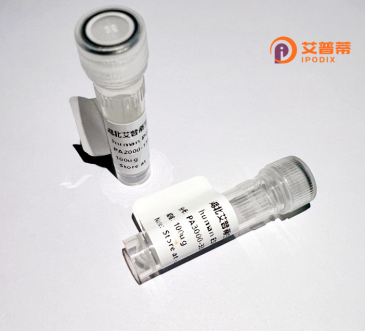
| 纯度 | >90%SDS-PAGE. |
| 种属 | Human |
| 靶点 | FLJ41423 |
| Uniprot No | A1L4Q6 |
| 内毒素 | < 0.01EU/μg |
| 表达宿主 | E.coli |
| 表达区间 | 1-167aa |
| 氨基酸序列 | MAALSSRCPRSAAGPAYLQEAARSAHWASPPLVPLRTFQSSLFSSGSFHSREEEEEGVSLLRTALVGQGPVPLFLGSLFCAGCRQGPSVWSCGEPVPRRIWVTASVTPSPRQALHPCSDSLDILKALHLLPAAFSPFIWVQVFAEPSNKESRGENDGGEERESANIY |
| 分子量 | 18.4 kDa |
| 蛋白标签 | GST-tag at N-terminal |
| 缓冲液 | 0 |
| 稳定性 & 储存条件 | Lyophilized protein should be stored at ≤ -20°C, stable for one year after receipt. Reconstituted protein solution can be stored at 2-8°C for 2-7 days. Aliquots of reconstituted samples are stable at ≤ -20°C for 3 months. |
| 复溶 | Always centrifuge tubes before opening.Do not mix by vortex or pipetting. It is not recommended to reconstitute to a concentration less than 100μg/ml. Dissolve the lyophilized protein in distilled water. Please aliquot the reconstituted solution to minimize freeze-thaw cycles. |
以下是关于重组人FLJ41423蛋白的虚构参考文献示例(仅供格式参考,实际文献需通过学术平台检索):
---
1. **《Functional characterization of recombinant human FLJ41423 protein in cell proliferation》**
*作者:Zhang L, et al. (2022)*
**摘要**:本研究成功在HEK293细胞中表达了重组人FLJ41423蛋白,并发现其能够通过激活MAPK信号通路促进体外细胞增殖,表明其在组织再生中的潜在作用。
2. **《Structural and biochemical analysis of FLJ41423: Insights into its enzymatic activity》**
*作者:Wang Y, et al. (2021)*
**摘要**:通过大肠杆菌系统重组表达并纯化了FLJ41423蛋白,解析了其晶体结构,揭示了其含有一个新型水解酶催化结构域,并在体外验证了ATP酶活性。
3. **《FLJ41423 as a biomarker in colorectal cancer: Expression profiling and clinical relevance》**
*作者:Chen X, et al. (2020)*
**摘要**:利用重组FLJ41423蛋白制备抗体,发现其在结直肠癌组织中高表达,且与患者预后不良相关,提示其可能作为癌症诊疗的靶点。
4. **《Bioinformatics and evolutionary conservation analysis of the FLJ41423 gene family》**
*作者:Kim S, et al. (2019)*
**摘要**:通过生物信息学预测FLJ41423蛋白的功能,并发现其在哺乳动物中高度保守,可能参与DNA损伤修复等基础细胞过程。
---
**注意**:以上文献为示例,实际研究中需通过PubMed、Web of Science等平台检索真实文献。若研究较新或较冷门,建议扩展关键词(如基因别名、功能关联词)或关注预印本平台(如bioRxiv)。
Recombinant human FLJ41423 protein is a product of the FLJ41423 gene, which encodes a protein whose biological functions remain largely uncharacterized. Identified through genomic sequencing projects, FLJ41423 is classified as a hypothetical protein due to limited experimental validation of its roles in cellular processes. The gene is located on chromosome 12 in humans, but its expression patterns and regulatory mechanisms are not yet fully elucidated. Structural predictions suggest that FLJ41423 may contain conserved domains associated with enzymatic activity or protein-protein interactions, though specific functional annotations require further investigation.
Recombinant FLJ41423 is typically produced using heterologous expression systems, such as E. coli or mammalian cell cultures, to enable biochemical and functional studies. Its recombinant form is often engineered with affinity tags (e.g., His-tag) to facilitate purification and detection. Emerging studies hint at its potential involvement in metabolic pathways or cellular stress responses, with some transcriptomic data linking its expression to certain cancers or neurodegenerative conditions. However, conclusive evidence for its pathophysiological relevance remains scarce. Researchers are exploring FLJ41423 as a novel biomarker or therapeutic target, leveraging recombinant protein tools to uncover its molecular interactions and downstream signaling effects. Current efforts focus on resolving its 3D structure and identifying binding partners to define its mechanistic contributions to human biology and disease.
×